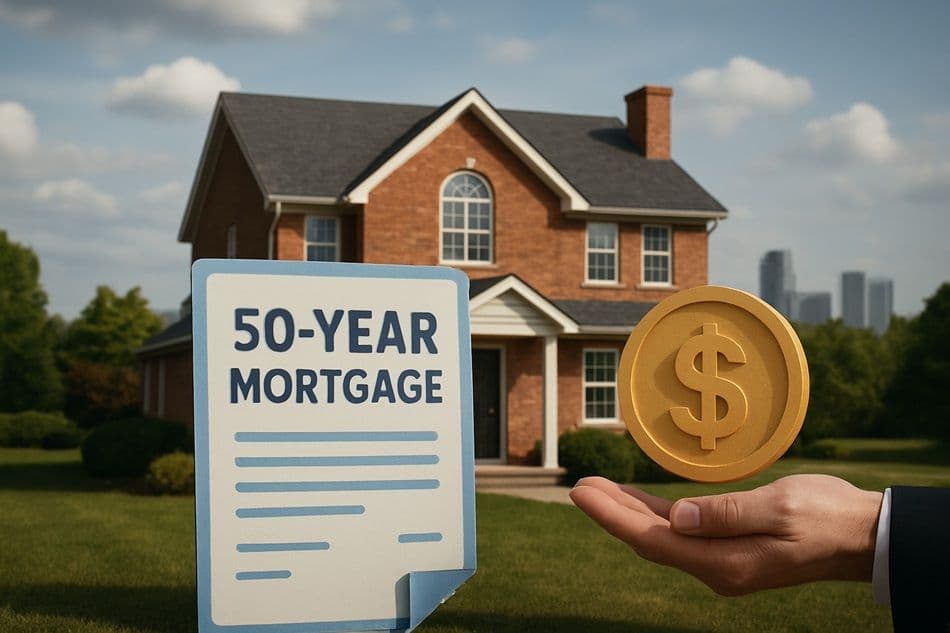Ask GRAI Anything
Your Real Estate Questions, Answered Instantly via Chat


Help us make GRAI even better by sharing your feature requests.

When President Donald Trump announced this week that his administration is exploring a 50-year federally backed mortgage, it landed like a thunderclap across financial markets.
For some, it was long-overdue innovation - a way to make housing affordable again. For others, it felt like history repeating - another form of easy credit disguised as reform.
Yet beyond the political noise, this proposal may do something far more profound: redefine how Americans build wealth and how global investors price real estate for the next half-century.
Stretching repayment from 30 to 50 years trims monthly payments by 10% to 13%, according to mortgage experts. That reduction could bring millions of renters back into the buying pool - especially in markets like Texas, Florida, and Arizona, where the average first-home price now exceeds $441,802.
But the trade-off is steep. Over the life of the loan, total interest paid rises by 60%-80%, and meaningful equity doesn’t accumulate until well past year 30. It buys access - not ownership.
Analysts at Moody’s Analytics project that introducing 50-year mortgages could lift U.S. home prices by +0.48% in 2026, even without major rate cuts.
Builders price homes to the payment, not the principle.
When the payment gets smaller, the price ceiling rises.
That keeps demand alive - but also extends risk. The average loan-to-value ratio for new buyers could move above 92%, leaving millions highly leveraged for decades.
It is affordability by deferral.
At a system level, longer loans extend the nation’s credit cycle. Banks gain a lucrative, long-duration asset to securitize. Homeowners carry the longest debt exposure in modern history. And the economy gets short-term stimulus at the cost of long-term resilience.
Japan introduced 100-year, inter-generational mortgages after its 1990s property crash. Prices stabilized, but the market froze - homes became heirlooms of debt.
After 2008, Spain introduced 40-year mortgages, while the U.K. extended loan terms to 25–35 years. These measures kept nominal housing prices elevated, but they also reduced mobility and slowed overall market recovery.
The pattern is clear: ultra-long mortgages slow correction, preserve asset values, and quietly transfer risk to the future.
A 50-year mortgage blurs the line between housing and investment. It makes property behave more like a long-duration bond - predictable cash flow, modest yield, heavy interest exposure.
To understand its implications, compare it with what other major assets have done over 50 years.
| Asset | 1975 → 2025 Performance | Compound Annual Growth Rate | Notes |
|---|---|---|---|
| U.S. Residential Real Estate | ≈+1,450% (total) | ≈6% CAGR | Driven by credit expansion and urbanization |
| S&P 500 Index | ≈+33,755% (total) | ≈9% CAGR | Volatile, equity-based, compounding returns |
| Gold | ≈+2,900% (total) | ≈9%–11% CAGR | Stores value, no yield, cyclical spikes |
| Bitcoin (since 2010) | ≈+50,000,000% (total) | ≈140% CAGR (since 2010) | High-risk, non-linear, speculative asset |
The takeaway: real estate sits between gold and equities - less volatile, but highly policy-sensitive.
A 50-year mortgage tilts that balance even further toward “store of value,” prioritizing stability over liquidity.
It effectively locks capital into an asset class that already represents ~70% of global household wealth.
Must Read: Real Estate vs Bitcoin vs Gold in 2025: Which Asset Class Deserves Your Capital?
If this policy succeeds in expanding credit access without sparking defaults, it could create a new floor for housing values.
In theory, cheaper monthly payments lift demand and keep appreciation alive even in high-rate environments.
That could benefit:
Existing homeowners, who see equity inflate again.
Builders and REITs, who gain pricing power.
Global investors searching for long-duration yield.
But it also entrenches inequality. Younger generations will build equity slowly; older ones will watch their net worth compound faster.
The wealth gap widens - just more quietly.
Also Read: The Institutional Land Grab: How Funds and REITs Are Buying the Future of Housing
The most striking implication of a 50-year mortgage isn’t financial - it’s generational.
A loan starting in 2026 could run until 2076. That means many borrowers will die before full repayment.
In effect, the home becomes a multi-generational financial asset - owned partly by the family, partly by the bank, and partly by the market.
That’s not the American Dream of 1950.
It’s the financial architecture of 2050.
Instead of speculating, GRAI lets you simulate what a 50-year lending world actually looks like:
“Compare total interest and equity trajectory for 30 vs 50-year mortgage at 6.5 %.”
“Forecast home-price appreciation if ultra-long loans expand nationwide.”
“Model portfolio diversification: real estate vs S&P 500 vs gold vs crypto (1975–2025).”
“Simulate systemic-risk exposure under prolonged leverage growth.”
Model Your 50-Year Mortgage Impact with GRAI : https://internationalreal.estate/chat
Because housing policy is now an investment policy - and only an AI that sees the full picture can tell you where they intersect.
A 50-year mortgage is neither savior nor disaster. It’s a mirror - reflecting how far we’ll stretch time to preserve the illusion of affordability.
It could fuel one more decade of appreciation, stabilize markets, and quietly expand household wealth - or it could defer the next crisis until today’s buyers are gone.
Either way, it confirms one truth:
Real estate has stopped being a short-term bet on shelter and become a long-term wager on society’s ability to keep believing in credit.